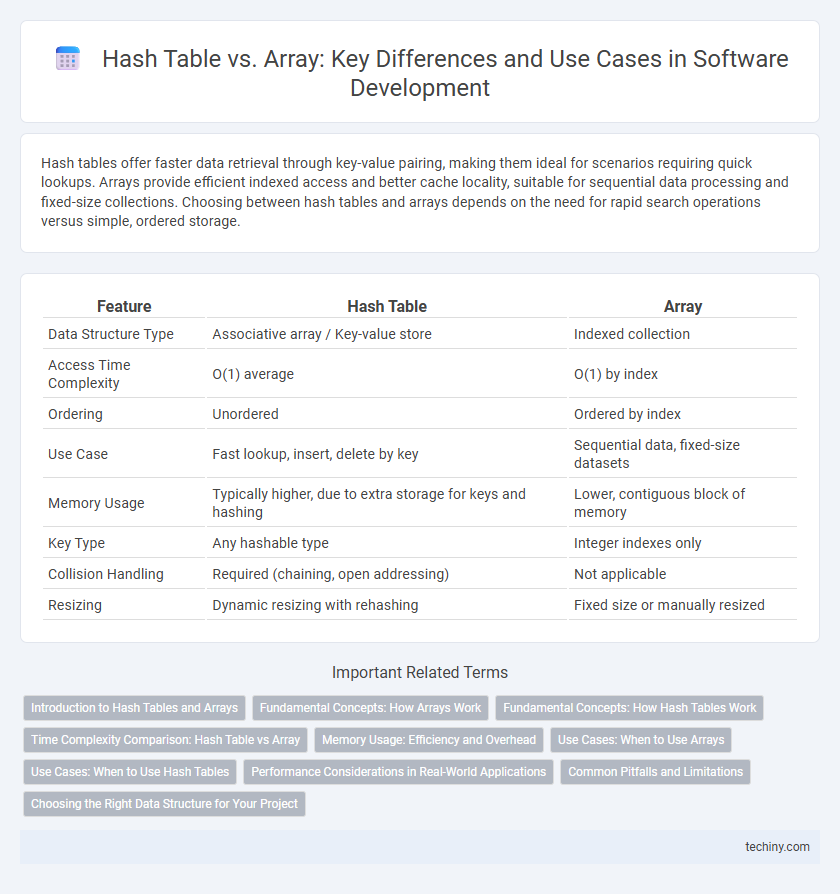Hash tables offer faster data retrieval through key-value pairing, making them ideal for scenarios requiring quick lookups. Arrays provide efficient indexed access and better cache locality, suitable for sequential data processing and fixed-size collections. Choosing between hash tables and arrays depends on the need for rapid search operations versus simple, ordered storage.
Table of Comparison
| Feature | Hash Table | Array |
|---|---|---|
| Data Structure Type | Associative array / Key-value store | Indexed collection |
| Access Time Complexity | O(1) average | O(1) by index |
| Ordering | Unordered | Ordered by index |
| Use Case | Fast lookup, insert, delete by key | Sequential data, fixed-size datasets |
| Memory Usage | Typically higher, due to extra storage for keys and hashing | Lower, contiguous block of memory |
| Key Type | Any hashable type | Integer indexes only |
| Collision Handling | Required (chaining, open addressing) | Not applicable |
| Resizing | Dynamic resizing with rehashing | Fixed size or manually resized |
Introduction to Hash Tables and Arrays
Hash tables store key-value pairs and offer average-case constant time complexity O(1) for search, insertion, and deletion, making them efficient for dynamic datasets requiring fast lookups. Arrays consist of indexed elements stored contiguously in memory, providing constant time access O(1) based on index but less efficient for search operations with O(n) time complexity. Selecting between hash tables and arrays depends on whether the use case prioritizes fast indexed access or rapid key-based retrieval.
Fundamental Concepts: How Arrays Work
Arrays store elements in contiguous memory locations, allowing constant-time access via index-based addressing. Their fixed size requires predefined allocation, which can lead to inefficiencies when resizing is needed. In contrast, hash tables use a hash function to map keys to indices, enabling efficient key-value pair retrieval beyond simple positional access.
Fundamental Concepts: How Hash Tables Work
Hash tables store data using a hash function that converts keys into unique indices, allowing for average constant-time complexity O(1) in search, insertion, and deletion operations. Unlike arrays, which use continuous memory locations and integer indices, hash tables handle dynamic and non-integer keys by resolving collisions through methods like chaining or open addressing. This fundamental mechanism enables hash tables to efficiently manage key-value pairs in software development tasks such as caching, indexing, and associative arrays.
Time Complexity Comparison: Hash Table vs Array
Hash tables offer average-case time complexity of O(1) for search, insert, and delete operations, making them highly efficient for dynamic data access. Arrays provide O(1) time complexity for element access by index but suffer from O(n) time complexity for search and insertion unless elements are accessed sequentially or added at the end. Choosing between a hash table and an array depends on whether constant-time key-based retrieval or indexed access is prioritized in software development tasks.
Memory Usage: Efficiency and Overhead
Hash tables typically consume more memory than arrays due to storage requirements for keys, values, and handling collisions through pointers or linked lists. Arrays allocate memory contiguously, offering minimal overhead and efficient cache utilization, which reduces access time and memory usage. Memory efficiency in hash tables varies based on load factor and collision resolution strategy, whereas arrays maintain fixed size with predictable, low overhead.
Use Cases: When to Use Arrays
Arrays are ideal for scenarios requiring sequential data storage with fixed-size collections and fast indexed access, such as storing lists of items, implementing buffers, or managing data caches. They excel in situations where memory allocation is predictable and elements are accessed by position rather than by key. Use arrays when operations predominantly involve iteration, sorting, or when the data size remains constant throughout processing.
Use Cases: When to Use Hash Tables
Hash tables excel in scenarios requiring fast lookups, insertions, and deletions, such as implementing caches, databases indexing, or symbol tables in compilers. Their average O(1) time complexity for search operations makes them ideal for managing large datasets with unpredictable access patterns. Use hash tables when key-value pairing and efficient retrieval outweigh the need for ordered data.
Performance Considerations in Real-World Applications
Hash tables provide average-case constant time complexity O(1) for search, insert, and delete operations, making them highly efficient for dynamic datasets requiring frequent lookups. Arrays offer faster access times for static data due to contiguous memory allocation, resulting in O(1) index-based retrieval but exhibit slower insertion and deletion times with O(n) complexity. In real-world applications, the choice between hash tables and arrays depends on factors like dataset mutability, memory constraints, and the need for ordered data traversal.
Common Pitfalls and Limitations
Hash tables often face challenges with collision resolution and memory overhead, impacting performance when handling large datasets or poorly distributed keys. Arrays have fixed sizes and require contiguous memory allocation, limiting dynamic resizing and efficient insertion or deletion operations. Both structures can suffer from cache inefficiency, but arrays typically provide better cache locality compared to hash tables.
Choosing the Right Data Structure for Your Project
Hash tables provide average constant-time complexity O(1) for insertions, deletions, and lookups, making them ideal for applications requiring fast access to data using unique keys. Arrays offer efficient memory usage and cache performance with O(1) access time by index, suitable for sequential data storage and iteration. Selecting the right structure depends on the project's needs: hash tables excel in dynamic datasets with frequent searches, while arrays are preferable for fixed-size collections requiring ordered traversal.
Hash Table vs Array Infographic

 techiny.com
techiny.com